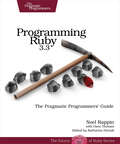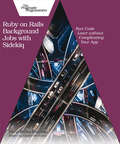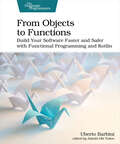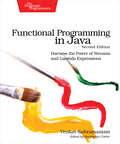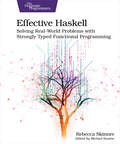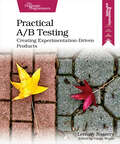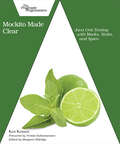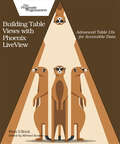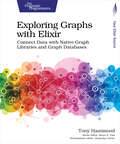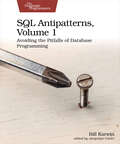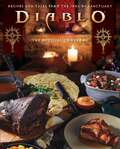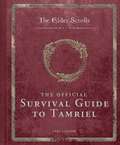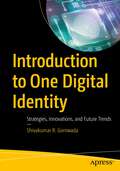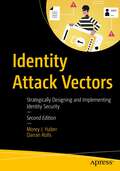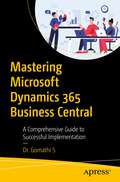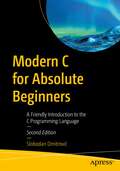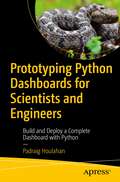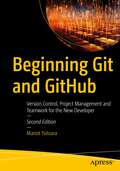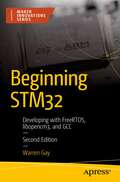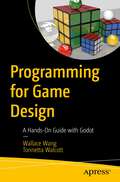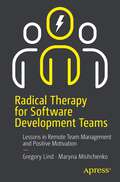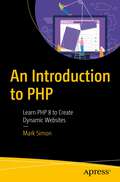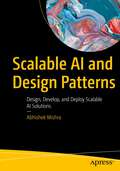- Table View
- List View
Programming Ruby 3.3
by Noel Rappin Dave ThomasRuby is one of the most important programming languages in use for web development. It powers the Rails framework, which is the backing of some of the most important sites on the web. The Pickaxe Book, named for the tool on the cover, is the definitive reference on Ruby, a highly-regarded, fully object-oriented programming language. This updated edition is a comprehensive reference on the language itself, with a tutorial on the most important features of Ruby - including pattern matching and Ractors - and describes the language through Ruby 3.3. Would you like to go from first idea to working code much, much faster? Do you currently spend more time satisfying the compiler instead of your clients or end users? Are you frustrated with demanding languages that seem to get in your way instead of helping you get the work done? Are you using Rails and want to dig deeper into the underlying Ruby language? If so, then we've got a language and book for you! Ruby is a fully object-oriented language. The combination of the power of a pure object-oriented language with the convenience of a scripting language makes Ruby a favorite tool of programmers that want to get things done quickly and cleanly. This comprehensive reference manual for Ruby includes a description of the most important standard library modules, built-in classes, and modules. It also includes all the new and changed syntax and semantics introduced through Ruby 3.3, including pattern matching and Ractors, and describes the language through Ruby 3.3. What You Need: This book assumes you have a basic understanding of object-oriented programming. In general, Ruby programmers tend to favor the the command line for running their code, and they tend to use text editors rather than IDEs. Ruby runs on Windows, Linux, and MacOS.
Charged Bodies: People, Power, And Paradox In Silicon Valley
by Thomas MahonAt the heart of Silicon Valley's meteoric rise is a story etched in the lives of those who shaped it and those who were forever transformed by it. Author Tom Mahon provides an insider's perspective on the birth of the semiconductor industry, which sparked the region's transformation from sleepy farmland to the heart and soul of the high-tech revolution. Through twenty-five extended, in-person interviews you'll meet a diverse cast of characters whose goal was to create technology and tools in service to humanity. In the Afterword to this edition, the author questions whether they accomplished their objectives and urges readers to rise up and rethink technology. What did it take to create the atmosphere that transformed rich farmland into the wealthy center of high-tech? Five climates lined up in just the right way. Educational institutions (Stanford and Berkeley); an attractive location with balmy, Mediterranean-like weather; a history of technology development (Federal Telegraph in the early twentieth century); financial risk taking (the gold rush); and a cultural climate near the center of an ideological revolution (the hippie movement). The Santa Clara Valley had them all. In spades. Before personal computers, or the Internet, or social media came *chips*. Inventive minds took advantage of the quad-electron structure and unique properties - insulative and conductive - of silicon to create semiconductors. But Charged Bodies is more than just the story of new technologies emerging from "The Valley of the Heart's Delight." Using an approach like The Canterbury Tales, Tom Mahon captures the spirit of Silicon Valley in the 80s through the stories of the people all around him. The inventors and bankers have their say. But so do a range of other people who lived through that transition. Listen as artists and hackers, detectives and journalists, lawyers and scientists, flappers and philosophers tell the story of Silicon Valley in their own words.
Ruby on Rails Background Jobs with Sidekiq
by David B. CopelandOne of the best ways to improve your Rails app’s performance is to use background jobs with Sidekiq. While Sidekiq is easy to get set up, you need to do more than just move code around to reap the benefits. In this book, you’ll get solutions to what sort of code should go into a Sidekiq job and how to manage those jobs. You’ll create a Sidekiq configuration that will serve as a solid foundation for your app, including how to be notified when jobs inevitably fail. You’ll then tame alerting fatigue by designing idempotent jobs that can be safely retried in the face of the types of transient failures that are common in networked applications, all without alerting you until action is needed. With that foundation, you’ll get a conceptual framework for general monitoring and alerting around your Sidekiq installation and the Redis database it uses, as well as practical tips for organizing the code around your Sidekiq jobs. You’ll also learn valuable testing strategies for code that uses Sidekiq jobs. In no time at all you’ll build a Rails app using Sidekiq that is efficient, manageable, and sustainable. Using Sidekiq for background jobs is a great way to scale and grow your app. This book will give you a solid, practical foundation for creating resilient, well-tested, self-healing code that uses background jobs. You’ll be able to simulate real-world failure modes and learn how to write idempotent code that can be safely run with Sidekiq. Buy this DRM-free Pragmatic Bookshelf ebook today!Using Sidekiq for background jobs is a great way to scale and grow your app. This book will give you a solid, practical foundation for creating resilient, well-tested, self-healing code that uses background jobs. You’ll be able to simulate real-world failure modes and learn how to write idempotent code that can be safely run with Sidekiq.
From Objects to Functions: Build Your Software Faster And Safer With Functional Programming And Kotlin
by Uberto BarbiniBuild applications quicker and with less effort using functional programming and Kotlin. Learn by building a complete application, from gathering requirements to delivering a microservice architecture following functional programming principles. Learn how to implement CQRS and EventSourcing in a functional way to map the domain into code better and to keep the cost of change low for the whole application life cycle. If you're curious about functional programming or you are struggling with how to put it into practice, this guide will help you increase your productivity composing small functions together instead of creating fat objects. Switching to the functional paradigm isn't easy when you're used to object-oriented programming. You need more than just lambdas and mapping over collections to get a declarative style and disentangle the state from the computations. Use transformations and compositions to help you write less code with better results. Boost your productivity and harness the power of functional programming by creating real-world applications rather than focusing on theoretical concepts. Work through a series of short exercises to find and compose pure functions, and create data structures that work like algebra. Get rid of mutable state in your software to eliminate the main source of bugs. Apply CQRS and EventSourcing patterns to translate stakeholder requirements into functional design and then into code. See how Kotlin's easy-to-learn syntax and functional-friendly approach make it a great option for a pragmatic language that integrates well with existing Java code and libraries. Leverage functional programming to build and deliver robust applications in less time and with fewer defects. What You Need: The code in this book is designed to allow you to build your application from scratch on Windows, Mac and Linux. You will need a recent IDE, we recommend IntelliJ Community Edition, and Kotlin 1.3.x or later.
Functional Programming in Java
by Venkat SubramaniamImagine writing Java code that reads like the problem statement, code that's highly expressive, concise, easy to read and modify, and has reduced complexity. With the functional programming capabilities in Java, that's not a fantasy. This book will guide you from the familiar imperative style through the practical aspects of functional programming, using plenty of examples. Apply the techniques you learn to turn highly complex imperative code into elegant and easy-to-understand functional-style code. Updated to the latest version of Java, this edition has four new chapters on error handling, refactoring to functional style, transforming data, and idioms of functional programming. Don't struggle with the limitations of the imperative style; instead learn to combine object-oriented programming with the functional style to reduce the accidental complexity. Harness the functional programming capabilities of Java to create applications where the program reveals its intentions and your team can quickly understand and modify code to align with changing business requirements. Unlock the power of lambda expressions and the Streams API to turn the oft-written spaghetti code into highly concise, expressive, elegant, and maintainable code. See how Streams make the arduous task of parallelizing code as easy as flipping a switch when superior speed is necessary. Apply design patterns built around lambda expressions, safely manage resource allocations, use memoization, and learn to transform data into different forms, all while honoring immutability, and providing thread safety to leverage lazy evaluation for efficiency and parallel execution for performance. Move beyond the basics, explore the idioms for writing functional programs. Learn to think functionally by refactoring legacy code into the functional style. And, if your code runs aground due to failures, learn to properly handle errors the functional way.Don't drown in theory; instead learn the practical functional programming techniques to create superior Java code.What You Need:Java version 8 or newer.
Effective Haskell
by Rebecca SkinnerPut the power of Haskell to work in your programs, learning from an engineer who uses Haskell daily to get practical work done efficiently. Leverage powerful features like Monad Transformers and Type Families to build useful applications. Realize the benefits of a pure functional language, like protecting your code from side effects. Manage concurrent processes fearlessly. Apply functional techniques to working with databases and building RESTful services. Don't get bogged down in theory, but learn to employ advanced programming concepts to solve real-world problems. Don't just learn the syntax, but dive deeply into Haskell as you build efficient, well-tested programs. Haskell is a pure functional programming language with a rich ecosystem of tools and libraries. Designed to push the boundaries of programming, it offers unparalleled power for building reliable and maintainable systems. But to unleash that power, you need a guide. Effective Haskell is that guide. Written by an engineer who understands how to apply Haskell to the real world and uses it daily to get practical work done, it is your ticket to Haskell mastery.Gain deep understanding of how Haskell deals with IO and the outside world by writing a complete Haskell application that does several different kinds of IO. Reinforce your learnings with practice exercises in every chapter.Write stable and performant code using Haskell's type system, code that is easier to grow and refactor. Leverage the power of pure functional programming to improve collaboration, make concurrency safe and easy, and make large code bases manageable.Implement type-safe web services, write generative tests, design strongly typed embedded domain-specific languages, and build applications that exploit parallelism and concurrency without fear of deadlocks and race conditions. Create and deploy cloud-native Haskell applications. Master the performance characteristics of functional applications to make them run faster and use less memory.Write Haskell programs that solve real-world business problems.What You Need:Intel based Mac, M1 Macs, Linux PC, or Windows with WSL2ghcup (http://www. Haskell.org/ghcup/)An active internet connection will be required for some projects.
Practical A/B Testing: Creating Experimentation-driven Products
by Leemay NasseryWhether you're a catalyst for organizational change or have the support you need to create an engineering culture that embraces A/B testing, this book will help you do it right. The step-by-step instructions will demystify the entire process, from constructing an A/B test to breaking down the decision factors to build an engineering platform. When you're ready to run the A/B test of your dreams, you'll have the perfect blueprint.With smart, tactful approaches to orchestrating A/B testing on a product, you'll quickly discover how to reap all the benefits that A/B testing has to offer - benefits that span your users, your product, and your team. Take the reins today, and be the change you want to see in your engineering and product organizations.Develop a hypothesis statement that's backed with metrics that demonstrate if your prediction for the experiment is correct. Build more inclusive products by leveraging audience segmentation strategies and ad-hoc post analysis to better understand the impact of changes on specific user groups. Determine which path is best for your team when deciding whether to go with a third-party A/B test framework or to build the A/B testing platform in-house. And finally, learn how to cultivate an experimentation-friendly culture within your team.Leverage the A/B testing methodology to demonstrate the impact of changes on a product to your users, your key business metrics, and the way your team works together. After all, if you aren't measuring the impact of the changes you make, how will you know if you're truly making improvements?
Mockito Made Clear
by Ken KousenMockito is the most popular framework in the Java world for automating unit testing with dependencies. Learn the Mockito API and how and when to use stubs, mocks, and spies. On a deeper level, discover why the framework does what it does and how it can simplify unit testing in Java. Using Mockito, you'll be able to isolate the code you want to test from the behavior or state of external dependencies without coding details of the dependency. You'll gain insights into the Mockito API, save time when unit testing, and have confidence in your Java programs. If you've only ever run a few JUnit tests or injected stubs into classes to return preset values, it's time to level up your Java toolbox. Dependencies on other classes and external resources can obscure issues and make bugs hard to detect. You need to test classes in isolation to truly pinpoint your problems. And while you could write dummy classes to replace dependencies yourself, Mockito automates the process and helps you fix your code faster. Start with the Mockito API to generate fake classes for dependencies, configure how each should respond when their methods are called, and verify that the class under test interacts with dependencies the way you'd expect. Next, build unit tests with the Mockito framework and feel confident not just that methods are called, but that they are called the correct number of times and in the correct order. Along the way, follow clear test examples based on JUnit 5 to create stubs, mocks, and spies and find the source of any problems lurking in Java classes. Save time, write better code, and have more confidence in your Java programs with Mockito. What You Need: In this book, we use Mockito 4, the latest version of the Mockito framework, but the concepts and the code works on versions 2 and 3. The tests are based on JUnit 5 (known as Jupiter). There are some differences in JUnit 4, but none of those affect Mockito directly. The underlying Java version is 11, but the provided tests in the GitHub repository will work successfully for any version of Java above that (including the current Long Term Support version, 17).
Building Table Views with Phoenix LiveView
by Peter UllrichAs a web developer, you have to build tables. Lots and lots of tables. With table UIs making up such a significant part of your daily work, you need to know how to build the right table for the task, with all the needed features. Building a simple table is easy, but tables only become really useful with advanced features like pagination, sorting, and filtering. That’s where building a table can quickly become complicated. This book shows you how to implement advanced table features in a clean and reusable way. You’ll build fast and interactive table UIs by leveraging Phoenix LiveView. Make vast amounts of data manageable with common but complex features like pagination, sorting, filtering, and inifinity scrolling. Use SOLID coding principles to make your queries reusable with query composition. Compartmentalize your UI with LiveComponents and learn how to handle user input securely with schemaless changesets. Share your view onto the data painlessly by storing your search parameters in the URL. Data is one of the most valuable assets of your business, but you cannot unlock its potential if you don’t know how to make it accessible. This book shows you how to deliver that data to your users’ fingertips quickly. ","Data is at the core of every business, but it is useless if nobody can access and analyze it. Learn how to generate business value by making your data accessible with advanced table UIs. This definitive guide teaches you how to bring your data to the fingertips of nontechnical users with advanced features like pagination, sorting, filtering, and infinity scrolling. Build reactive and reuseable table components by leveraging Phoenix LiveView, schemaless changesets, and Ecto query composition. Table UIs are the bread and butter for every web developer, so it is time to learn how to build them right.
Exploring Graphs with Elixir
by Tony HammondData is everywhere - it's just not very well connected, which makes it super hard to relate dataset to dataset. Using graphs as the underlying glue, you can readily join data together and create navigation paths across diverse sets of data. Add Elixir, with its awesome power of concurrency, and you'll soon be mastering data networks. Learn how different graph models can be accessed and used from within Elixir and how you can build a robust semantics overlay on top of graph data structures. We'll start from the basics and examine the main graph paradigms. Get ready to embrace the world of connected data! Graphs provide an intuitive and highly flexible means for organizing and querying huge amounts of loosely coupled data items. These data networks, or graphs in math speak, are typically stored and queried using graph databases. Elixir, with its noted support for fault tolerance and concurrency, stands out as a language eminently suited to processing sparsely connected and distributed datasets. Using Elixir and graph-aware packages in the Elixir ecosystem, you'll easily be able to fit your data to graphs and networks, and gain new information insights. Build a testbed app for comparing native graph data with external graph databases. Develop a set of applications under a single umbrella app to drill down into graph structures. Build graph models in Elixir, and query graph databases of various stripes - using Cypher and Gremlin with property graphs and SPARQL with RDF graphs. Transform data from one graph modeling regime to another. Understand why property graphs are especially good at graph traversal problems, while RDF graphs shine at integrating different semantic models and can scale up to web proportions. Harness the outstanding power of concurrent processing in Elixir to work with distributed graph datasets and manage data at scale. What You Need: To follow along with the book, you should have Elixir 1.10+ installed. The book will guide you through setting up an umbrella application for a graph testbed using a variety of graph databases for which Java SDK 8+ is generally required. Instructions for installing the graph databases are given in an appendix.
SQL Antipatterns, Volume 1: Avoiding The Pitfalls Of Database Programming
by Bill KarwinSQL is the ubiquitous language for software developers working with structured data. Most developers who rely on SQL are experts in their favorite language (such as Java, Python, or Go), but they're not experts in SQL. They often depend on antipatterns - solutions that look right but become increasingly painful to work with as you uncover their hidden costs. Learn to identify and avoid many of these common blunders. Refactor an inherited nightmare into a data model that really works. Updated for the current versions of MySQL and Python, this new edition adds a dozen brand new mini-antipatterns for quick wins. No matter which platform, framework, or language you use, the database is the foundation of your application, and the SQL database language is the standard for working with it. Antipatterns are solutions that look simple at the surface, but soon mire you down with needless work. Learn to identify these traps, and craft better solutions for the often-asked questions in this book. Avoid the mistakes that lead to poor performance and quality, and master the principles that make SQL a powerful and flexible tool for handling data and logic. Dive deep into SQL and database design, and learn to recognize the most common missteps made by software developers in database modeling, SQL query logic, and code design of data-driven applications. See practical examples of misconceptions about SQL that can lure software projects astray. Find the greatest value in each group of data. Understand why an intersection table may be your new best friend. Store passwords securely and don't reinvent the wheel. Handle NULL values like a pro. Defend your web applications against the security weakness of SQL injection. Use SQL the right way - it can save you from headaches and needless work, and let your application really shine! What You Need: The SQL examples use the MySQL 8.0 flavor, but other popular brands of RDBMS are mentioned. Other code examples use Python 3.9+ or Ruby 2.7+.
Diablo: Recipes and Tales from the Inns of Sanctuary
by Andy Lunique Rick BarbaTake a culinary journey through the dark fantasy world of Sanctuary with Diablo: The Official Cookbook, a flavorful compilation of recipes inspired by Blizzard Entertainment&’s iconic series.Journey through Sanctuary and prepare to feast on over 60 unique culinary delights inspired by Diablo in this one-of-a-kind cookbook experience. From the humble town of Tristram to the towering Mount Arreat, you will learn how to survive the horrors of this dark, nightmarish fantasy world by enjoying delicious dishes from the Burning Hells to the High Heavens. Each immersive recipe features straightforward step-by-step instructions, mouthwatering full-color photos, and pairing suggestions, as well as numerous substitution tips. Whether you&’re cooking up a lavish banquet spread fit for a countess or some vittles for a solo quest, Diablo: The Official Cookbook brings the flavors of Sanctuary to your table. 60+ RECIPES: From hearty bites in the mists of Scosglen to feasts straight from the banquet tables of Khanduras, Diablo: The Official Cookbook includes recipes from every zone for every occasion. BRING THE GAME TO LIFE: Explore delectable dishes inspired by iconic locations such as Khejistan, Westmarch, and The Dreadlands, fan-favorite monsters and enemies, and beloved characters such as The Butcher, Diablo, Deckard Cain, and Archangel Tyrael. DISHES FOR EVERY SKILL LEVEL: With step-by-step instructions and beautiful photographs, learn to make incredible dishes to satisfy even the hungriest Barbarian.
My Pokémon Baking Book: Delightful Bakes Inspired by the World of Pokémon
by Insight EditionsBake delicious, colorful treats and create lasting memories in the kitchen with your team with these amazing recipes inspired by the world of Pokémon!Explore confections and desserts representing every region of the incredible Pokémon universe. Featuring favorite treats that celebrate beloved characters from the world of Pokémon, My Pokémon Baking Book is the perfect addition to any Pokémon Trainer's kitchen. Great for fans of all ages! 50+ RECIPES: From quick treats to share with friends to dazzling dessert displays perfect for celebrating a Pokémon League victory, My Pokémon Baking Book includes recipes for every occasion. REGIONAL SPECIALTIES: Explore favorite and unique flavors from every currently known region, including the newly discovered region, Paldea! FAVORITE CHARACTERS: Create cookies, cakes, breads, cupcakes, and more with bakery-fresh recipes inspired by Pikachu and friends! DISHES FOR EVERY SKILL LEVEL: With step-by-step instructions and beautiful photographs, My Pokémon Baking Book will teach you how to make iconic foods that bring the vibrant culinary sweets inspired by the world of Pokémon to life. Whether you&’re baking with other Trainers or your family, these easy-to-follow recipes will make you a baking master in no time! COMPLETE YOUR COLLECTION: Looking for more creative fun? My Pokémon Cookbook is available to take you on another Pokémon culinary adventure, while Pokémon Wisdom: A Journal for Embracing Your Inner Trainer provides creative journaling!
The Elder Scrolls: The Official Survival Guide to Tamriel
by Tori SchaferEnter the expansive world of The Elder Scrolls Online and discover how to survive the wilds of Tamriel!Based on the award-winning Elder Scrolls Online, The Elder Scrolls Online: The Official Survival Guide to Tamriel is the ultimate guide to surviving the harsh and stunning landscape of Tamriel. This deluxe volume features incredible tips, tricks, and information to not only help you make your way through Tamriel, but provide solid advice in the real world as well. · Everything you need to know. Tamriel is a harsh world, with many, many dangers. Find the tips and tricks you need to survive the perilous encounters there...and in the real world. · Don&’t cut your adventuring life short! Learn how to dress a wound, how to survive encounters with wildlife, and even how best to pack for the adventuring life. · A stunning addition to your collection. Featuring exclusive artwork and packed full of lore, this premium hardcover book is a must have for every Elder Scrolls fan.
Introduction to One Digital Identity: Strategies, Innovations, and Future Trends
by Shivakumar R. GoniwadaExplore the dynamics of digital identity, a crucial component in today’s modern technology-driven era. This engaging book offers a deep understanding of how digital identity is evolving rapidly, why it’s so significant, and offers organizations, regulatory bodies, and academicians the strategies needed to adopt secure decentralized digital identity features effectively. It’s a must-read for those aiming to grasp the intricacies of digital identity and leverage it for future innovation and security.The book begins by redefining digital identity, examining its evolution and the profound impact it has on both individuals and organizations. It then delves into the development of digital identity strategies, laying the foundation for future digital transformations. Covering a wide range of topics, the book discusses the innovation, challenges, and technological exploration in digital identity. A special focus is given to biometric technologies and the implementation of decentralized digital identities, addressing critical areas such as identity governance, blockchain, AI and advanced biometrics. The book also investigates the implications of digital identity across various industries, including cross border travel, healthcare, social media, finance, metaverse, IoT etc. finally the book provides not only emerging trends but offers a glimpse into the future digital identity. Whether you’re a tech professional, business leader, student or simply keen on understanding the impact of digital advancements, this book promises to offer insightful perspectives and practical solutions for navigating the complex world of digital identity. It underscores the importance of identity in spearheading digital innovation, making it a key resource for anyone looking to stay ahead in the digital landscape. As you reach its conclusion, you’ll be equipped with a wealth of knowledge and insights that are crucial in today’s digital era.What You'll LearnDigital identity strategies and their role in shaping the future of digital identityDifferent facets of digital identitySpecifics of biometric technologies and decentralized digital identity Industry specific digital identity and its implementationCrucial aspects of privacy, ethics, and secure in the context of digital identityWho This Book Is ForSoftware professionals, security practitioners, architects, senior managers, executives, and students who are interested in digital identity.
Identity Attack Vectors: Strategically Designing and Implementing Identity Security, Second Edition
by Morey J. Haber Darran RollsToday, it’s easier for threat actors to simply log in versus hack in. As cyberattacks continue to increase in volume and sophistication, it’s not a matter of if, but when, your organization will have an incident. Threat actors target accounts, users, and their associated identities—whether human or machine, to initiate or progress their attack. Detecting and defending against these malicious activities should be the basis of all modern cybersecurity initiatives.This book details the risks associated with poor identity security hygiene, the techniques that external and internal threat actors leverage, and the operational best practices that organizations should adopt to protect against identity theft, account compromises, and to develop an effective identity and access security strategy. As a solution to these challenges, Identity Security has emerged as a cornerstone of modern Identity and Access Management (IAM) initiatives. Managing accounts, credentials, roles, entitlements, certifications, and attestation reporting for all identities is now a security and regulatory compliance requirement. In this book, you will discover how inadequate identity and privileged access controls can be exploited to compromise accounts and credentials within an organization. You will understand the modern identity threat landscape and learn how role-based identity assignments, entitlements, and auditing strategies can be used to mitigate the threats across an organization’s entire Identity Fabric. What You Will Learn Understand the concepts behind an identity and how its associated credentials and accounts can be leveraged as an attack vectorImplement an effective identity security strategy to manage identities and accounts based on roles and entitlements, including the most sensitive privileged accountsKnow the role that identity security controls play in the cyber kill chain and how privileges should be managed as a potential weak linkBuild upon industry standards and strategies such as Zero Trust to integrate key identity security technologies into a corporate ecosystemPlan for a successful identity and access security deployment; create an implementation scope and measurable risk reduction; design auditing, discovery, and regulatory reporting; and develop oversight based on real-world strategies to prevent identity attack vectors Who This Book Is For Management and implementers in IT operations, security, and auditing looking to understand and implement an Identity and Access Management (IAM) program and manage privileges in these environments
Mastering Microsoft Dynamics 365 Business Central: A Comprehensive Guide to Successful Implementation
by Dr. Gomathi SGet ready to ace Microsoft Dynamics 365 Business Central and usher in an era of streamlined efficiency, enhanced productivity, and growth. This guide book is your trusty companion on your journey to becoming an ERP implementation pro. The book will take you through the entire implementation process, from initial planning to successful deployment and beyond.The book starts with an introduction to Business Central and the benefits of its implementation. It discusses pre-implementation planning and vendor selection and partnership, and you will learn budgeting and timeline along with evaluating implementation partners. You will go through project management methodologies and learn about resource allocation and team roles. Data migration and cleansing are discussed, along with configuration and customization. You will learn about change management and user adoption, as well as Integration with existing systems. The book takes you through testing and quality assurance, and you will understand how to prepare for Go-Live. You also will learn common implementation challenges and solutions, and future trends in ERP and Business Central.After reading this book, you will be able to discover the full potential and make the most out of Microsoft Dynamics 365 Business Central.What Will You LearnMaster the complete process of Microsoft Dynamics 365 Business Central implementationImplement effective strategies to drive user adoption and overcome resistance to changeStay ahead of the curve by exploring emerging trends in the ERP landscapeUtilize practical tools and checklists to streamline implementation tasksGain insights from case studies for practical implementation strategiesWho This Book Is ForProject managers, business analysts, and ERP consultants
Modern C for Absolute Beginners: A Friendly Introduction to the C Programming Language
by Slobodan DmitrovićLearn the basics of C, the C standard library, and modern C standards. Complete with modern, up-to-date examples and screenshots, this new edition is fully updated and reworked with the latest C23 standards and features. C is a language that is as popular today as it was decades ago. It can be used to program a microcontroller or to develop an entire operating system. Author Slobodan Dmitrović takes you on a journey through the C programming language, the standard library, and the C standards basics. Each chapter is the right balance of theory and code examples. Written in a concise and easy-to-follow manner, this book will provide you all the essentials needed to start programming in modern C. What You Will LearnUnderstand C programming language and C standard library fundamentalsWork with new C standards featuresStudy the basics of types, operators, statements, arrays, functions, and structsReview the fundamentals of pointers, memory allocation, and memory manipulationTake advantage of best practices in CWho This Book Is For Beginner or novice programmers who wish to learn the C programming language. No prior programming experience is required.
Prototyping Python Dashboards for Scientists and Engineers: Build and Deploy a Complete Dashboard with Python
by Padraig HoulahanCreate interactive and data-driven dashboards using Python. This hands-on guide is a practical resource for those (with modest programming skills) in scientific and engineering fields looking to leverage Python's power for data visualization and analysis in a user-friendly dashboard format. You’ll begin by gaining a fundamental understanding of Python programming, including data types, lists, dictionaries, and data structures. The book then delves into the world of reactive programming with Plotly and Dash, offering a hands-on approach to building interactive web-based dashboards. Next, you’ll see how to work with online data, how to scrape and clean datasets, and keep files up-to-date. The book also guides you through planning a dashboard prototype, outlining project tasks, trends, forecasts, spectra, and other design considerations. It concludes with a discussion of how the dashboard can be used for data visualization of real data, explaining the usefulness of tools such as spectra. By providing detailed examples for download and customization, Prototyping Python Dashboards for Scientists and Engineers will equip you with the skills needed to jumpstart your own development efforts. What You’ll Learn Design a dashboard with PythonConvert and filter Excel formatted files to produce CSV filesCreate browser-served graphics with PLOTLYGenerate polynomial trend lines for forecastingBuild a Unix service to share your dashboard Who This Book Is For Scientists, engineers, students, programmers, and data enthusiasts who aspire to harness Python's potential for data visualization and analysis through the creation of interactive dashboards. Many will be pragmatic programmers with modest skills and limited resources who mainly want to see a working solution they could emulate.
Beginning Git and GitHub: Version Control, Project Management and Teamwork for the New Developer
by Mariot TsitoaraLearn the fundamentals of version control through step-by-step tutorials that will teach you the ins-and-outs of Git. This updated version introduces Github workflows, and contains new chapters on how to make Git and GitHub truly yours, covers additional common problems and how to solve them, along with new features of Github pull requests. Divided into three parts – Version Control, Project Management and Teamwork – this book reveals what waits for you in the real world and how to resolve the problems you may run into. Once past the basics of Git, you'll see how to manage a software project, and finally how to utilize Git and GithHub to work effectively as a team. You'll examine how to plan, follow and execute a project with GitHub, and then apply those concepts to real-world situations. Workaround the pitfalls that most programmers fall into when driving a project with Git by using proven tactics to avoid them. You will also be taught the easiest and quickest ways to resolve merge conflicts. A lot of modern books on Git don’t go into depth about non-technical topics. Beginning Git and GitHub is your complete guide to how Git and GitHub work in a professional team environment and will help you cover all the bases right at the start of your career. What You'll Learn Review basic and advanced concepts of GitApply Project Management skills using GitHub Solve conflicts or, ideally, avoid them altogether Use advanced concepts for a more boosted workflow Who This book Is For New developers, developers that have never worked in a team environment before, developers with basic knowledge of Git or GitHub, or anyone who works with text documents.
Beginning STM32: Developing with FreeRTOS, libopencm3, and GCC (Maker Innovations Series)
by Warren GaySee how using FreeRTOS and libopencm3 instead of the Arduino software environment will help you develop multi-tasking applications that go beyond Arduino norms. This updated version includes expanded coverage of software setup for Windows 10 and 11, additional TM32 hardware capabilities, including clear explanations of "totem pole outputs" versus "open drain outputs," and a new section on project showcasing an interrupt-driven approach for processing USART data.Each chapter contains clear explanations of the STM32 hardware capabilities to help get you started with the device, including GPIO and several other ST Microelectronics peripherals like USB and CAN bus controller. You’ll learn how to download and set up the libopencm3 + FreeRTOS development environment, using GCC. With everything set up, you’ll leverage FreeRTOS to create tasks, queues, and mutexes. You’ll also learn to work with the I2C bus to add GPIO using the PCF8574 chip. And how to create PWM output for RC control using hardware timers.You'll be introduced to new concepts that are necessary to master the STM32, such as how to extend code with GCC overlays using an external Winbond W25Q32 flash chip. Your knowledge is tested at the end of each chapter with exercises. Upon completing this book, you’ll be ready to work with any of the devices in the STM32 family. Beginning STM32, Second Edition provides the professional, student, or hobbyist a way to learn about ARM without costing an arm!What You'll Learn Initialize and use the libopencm3 drivers and handle interruptsUse DMA to drive a SPI based OLED displaying an analog meterRead PWM from an RC control using hardware timersUnderstand STM32 capabilities, including USB controller, RTC, DMA, CAN bus, and more Who This Book Is ForExperienced embedded engineers, students, hobbyists and makers wishing to explore the ARM architecture, going beyond Arduino limits.
Programming for Game Design: A Hands-On Guide with Godot
by Wallace Wang Tonnetta WalcottCreate video game elements using the Godot game engine, gaining practical experience in programming and video game development. The Godot game engine uses a simplified programming language called GDScript, which closely resembles Python. By learning GDScript, you can focus more on learning the basics of programming. You’ll explore concepts such as variables and data structures variables used to store information about video game objects that can be manipulated using a keyboard or a mouse. You’ll also learn about user interface design, branching statements, and looping statements, enabling you to actively engage in programming and create your own interactive games. By the end of the book, you’ll have a solid understanding of how video game elements work and how the basic principles of programming work as well. By programming simple video game elements in the Godot game engine, you’ll learn both programming and the principles of 2D video game design.What You Will LearnUnderstand the basics of programming by creating simple video game elements in the Godot game engine.Explore variables and data structures to actively store and modify information about video game objects.Gain a deeper understanding of user interface design.Master simplified programming languages like GDScript.Who This Book Is For Aspiring programmers and game enthusiasts seeking an engaging introduction to programming through video game creation.
Radical Therapy for Software Development Teams: Lessons in Remote Team Management and Positive Motivation
by Gregory Lind Maryna MishchenkoBuild and maintain effective, collaborative, and motivated software development teams. This book addresses the challenges in doing so, like communication gaps, trust issues, and motivation problems, and provides strategies to overcome them. You'll be introduced to the Radical Therapy Dev philosophy, a holistic approach designed to optimize software development teams for better performance and overall well-being. This book highlights common pain points in software development and offers solutions to resolving much of the issues in teams. It offers strategies for implementation, focusing on adaptability and accountability, while also promoting community-supported standards. And, the book reveals why an emphasis on fostering a growth mindset, mentorship programs, and junior-intern initiatives promotes continuous learning and collaboration.With the rise of remote work, you'll see why hiring globally while thinking locally is gaining popularity. You'll also gain insights into removing barriers to remote work, along with tools and policies for remote collaboration. Additionally, the book explores the concept of cloud-native software development and its benefits. Radical Therapy for Software Development Teams critiques the traditional "agile" methodology, identifying its shortcomings while extracting valuable lessons that can still be applied effectively. What You Will LearnAddress communication gaps, foster trust, and nurture a growth mindset among team membersAvoid common feedback mistakes, recognize accomplishments, and implement a reward systemImprove software development practices and team dynamics Take a scientific approach to project management rather than traditional requirements gatheringBreak Down Communication BarriersWho This Book is ForSoftware development professionals
An Introduction to PHP: Learn PHP 8 to Create Dynamic Websites
by Mark SimonUse PHP to enhance your web pages. This book shows you how PHP programming works, and how to write and organize PHP code. The book starts with steps to download and install a setup for a sample website that will form the basis for upcoming chapters. You start by writing PHP code and learn how to mix it with HTML and manage the code. From there, you will learn about dynamic content, along with a deep dive into form processing and sending email. Saving uploaded data and uploading files is discussed next. You will learn how to configure your PHP project and develop a library. You will then learn how to create an image catalog and manage data on your web page. By the end of the book, you will understand how to work with cookies, sessions, and logging in, followed by an example of creating a simple blog that reiterates the concepts developed in the previous chapters.After reading this book, you will be able to configure, create, and manage your dynamic website.What Will You LearnKnow the basics of programming with the PHP languageUse PHP to generate dynamic web pagesWork with SQL databasesWork with forms to upload text data and binary filesUse tips and tricks to write clean and maintainable codeWho This Book Is ForWeb developers and students learning to develop and maintain PHP code on their website
Scalable AI and Design Patterns: Design, Develop, and Deploy Scalable AI Solutions
by Abhishek MishraUnderstand and apply the design patterns outlined in this book to design, develop, and deploy scalable AI solutions that meet your organization's needs and drive innovation in the era of intelligent automation.This book begins with an overview of scalable AI systems and the importance of design patterns in creating robust intelligent solutions. It covers fundamental concepts and techniques for achieving scalability in AI systems, including data engineering practices and strategies. The book also addresses scalable algorithms, models, infrastructure, and architecture considerations. Additionally, it discusses deployment, productionization, real-time and streaming data, edge computing, governance, and ethics in scalable AI. Real-world case studies and best practices are presented, along with insights into future trends and emerging technologies.The book focuses on scalable AI and design patterns, providing an understanding of the challenges involved in developing AI systems that can handle large amounts of data, complex algorithms, and real-time processing. By exploring scalability, you will be empowered to design and implement AI solutions that can adapt to changing data requirements.What You Will LearnDevelop scalable AI systems that can handle large volumes of data, complex algorithms, and real-time processingKnow the significance of design patterns in creating robust intelligent solutionsUnderstand scalable algorithms and models to handle extensive data and computing requirements and build scalable AI systemsBe aware of the ethical implications of scalable AI systemsWho This Book Is ForAI practitioners, data scientists, and software engineers with intermediate-level AI knowledge and experience
